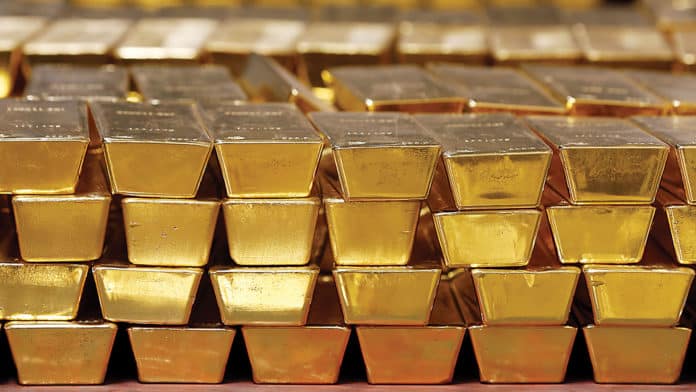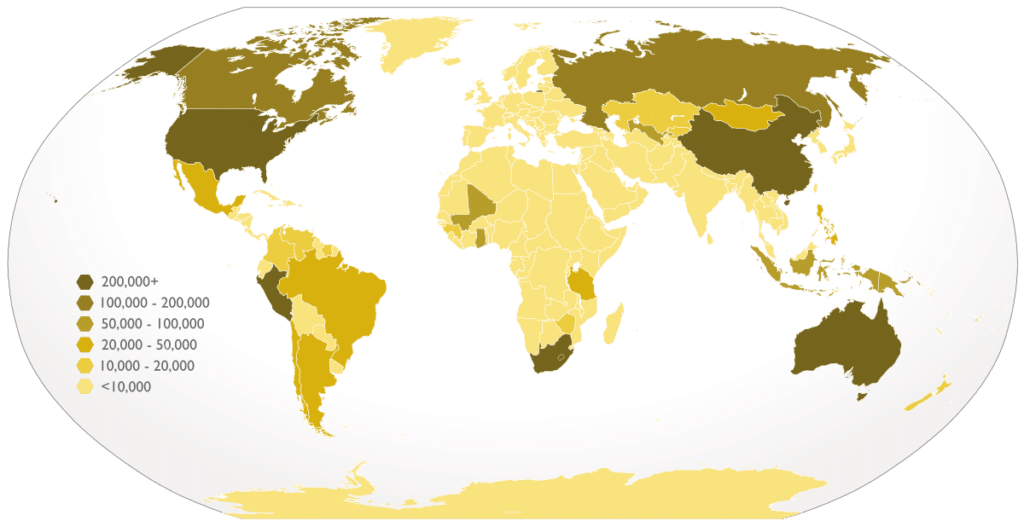Gold is a chemical element with the symbol Au, which comes from the Latin word for gold, “aurum.” It is a highly sought-after and valuable commodity due to its rarity, beauty, and unique properties.
Gold has a long and fascinating history. It was first discovered and used by ancient civilizations, such as the Egyptians and the Greeks, who considered it a symbol of power and wealth. In fact, gold was so highly valued that it was used as currency for many centuries.
As civilizations developed, gold continued to play a prominent role in society. It was used to create intricate jewelry, elaborate religious objects, and even as decoration for tombs and temples. Gold was also used in medicine, as it was believed to have healing properties.
Today, gold remains a valuable and highly prized commodity. It is used in a variety of industries, including electronics, dentistry, and aerospace. Gold is also used for investment purposes, as it is seen as a safe haven asset that can retain its value during times of economic uncertainty.
gold is a unique and valuable element that has played a significant role in human history. Its rarity, beauty, and unique properties make it highly sought-after, and it continues to be an important commodity in modern society.
How Much Gold Has Been Found in the World?
The total amount of gold that has been mined throughout history is difficult to determine with absolute certainty. However, estimates suggest that approximately 197,576 tonnes (218,077 tons) of gold have been mined up to 2021.
The majority of this gold has been extracted since the 19th century, with significant increases in production during the 20th century due to technological advancements and increased demand. The largest gold-producing countries include China, Australia, Russia, the United States, and Canada.
While it may seem like a significant amount of gold has been mined, it’s important to note that gold is still a relatively rare commodity. The amount of gold in the earth’s crust is estimated to be around 0.005 parts per million, meaning that it is more difficult and expensive to extract than other minerals.
Furthermore, the demand for gold continues to grow, particularly in emerging markets such as China and India. As a result, it’s likely that the amount of gold mined will continue to increase in the coming years.
while the exact amount of gold mined throughout history is difficult to determine, estimates suggest that approximately 197,576 tonnes of gold have been extracted. However, the rarity of gold and the growing demand for it means that it will likely remain a valuable commodity for years to come.
Where Can You Find Lots of Gold?
Gold can be found in various locations around the world, but some areas are known for producing more gold than others. Here are some of the top gold-producing countries and regions:
- China: China is currently the world’s largest gold producer, with an estimated 383 tonnes of gold produced in 2020. The country has been increasing its gold production in recent years and is home to some of the world’s largest gold mines.
- Australia: Australia is the second-largest gold producer in the world, with an estimated 320 tonnes of gold produced in 2020. The country is home to some of the world’s largest gold mines, including the Super Pit in Western Australia.
- Russia: Russia is the third-largest gold producer in the world, with an estimated 300 tonnes of gold produced in 2020. The country has a long history of gold mining, and many of its mines are located in remote areas of Siberia.
- United States: The United States is the fourth-largest gold producer in the world, with an estimated 190 tonnes of gold produced in 2020. Most of the country’s gold production comes from mines in Nevada, Alaska, and Colorado.
- Canada: Canada is the fifth-largest gold producer in the world, with an estimated 160 tonnes of gold produced in 2020. The country’s gold mines are located primarily in Ontario, Quebec, and British Columbia.
Other notable gold-producing countries and regions include South Africa, Peru, Ghana, and Indonesia.
gold can be found in various parts of the world, but some countries and regions are known for producing more gold than others. China, Australia, Russia, the United States, and Canada are some of the top gold-producing countries in the world.
Types of Gold Deposits
Gold deposits can be broadly categorized into three main types: placer, lode, and residual deposits.
- Placer Deposits: Placer deposits are the most common type of gold deposit and are formed by the accumulation of gold in riverbeds or other bodies of water. Gold is transported downstream by water and deposited in areas where the flow of water slows down, such as behind boulders or in eddies. Placer deposits are typically shallow and easy to mine, making them a popular target for small-scale miners.
- Lode Deposits: Lode deposits are veins of gold that are embedded in rock. These deposits are usually found in underground mines and can be difficult to extract. Lode deposits are often associated with other minerals, such as copper and lead, and are typically found in areas with high geological activity.
- Residual Deposits: Residual deposits are formed when gold is weathered and eroded from its original source and then re-deposited in a different location. These deposits are often found in areas where the bedrock has been exposed to weathering and erosion, such as in tropical environments. Residual deposits can be difficult to identify and are often found in remote areas.
It’s also worth noting that gold deposits can be found in a variety of rock types, including sedimentary, igneous, and metamorphic rocks. The formation of gold deposits is a complex process that is influenced by a variety of geological factors, including the type of rock, the presence of other minerals, and the activity of fluids in the earth’s crust.
there are three main types of gold deposits: placer, lode, and residual deposits. Each type of deposit has its own unique characteristics and requires different mining techniques. Understanding the formation of gold deposits is an important part of gold exploration and mining.
Gold Mining Methods
There are several methods used to extract gold from the earth, and each method has its own unique characteristics and challenges. Here are two of the most common methods:
- Placer Mining: Placer mining is the process of extracting gold from placer deposits, which are deposits of gold that have been concentrated by natural processes such as erosion and sedimentation. Placer mining involves using simple tools such as pans, sluice boxes, and rocker boxes to separate gold from gravel and sand. This method is relatively easy and inexpensive and is often used by small-scale miners.
- Hard Rock Mining: Hard rock mining is the process of extracting gold from veins of ore that are embedded in rock. This method involves drilling and blasting rock to access the veins of ore, which are then extracted using underground mining techniques. Hard rock mining is more expensive and requires more advanced equipment than placer mining, but it can yield more gold per ton of rock.
Other methods of gold mining include dredging, hydraulic mining, and open-pit mining. Dredging involves using a large floating machine to suck up gravel and sand from riverbeds or ocean floors, while hydraulic mining involves using high-pressure water jets to break up rock and extract gold. Open-pit mining is a method used to extract gold from large open pits in the ground.
Each method of gold mining has its own unique advantages and disadvantages, and the choice of mining method depends on a variety of factors, including the location of the deposit, the depth of the deposit, and the type of rock and soil surrounding the deposit.
there are several methods used to extract gold from the earth, including placer mining and hard rock mining. Each method has its own unique characteristics and challenges, and the choice of mining method depends on a variety of factors.
What is the Cost of Mining Gold?
The cost of mining gold can vary depending on a variety of factors, including the location of the mine, the type of mining operation, and the size and quality of the deposit.
Some of the major costs associated with gold mining include exploration and development, equipment and machinery, labor, and energy and fuel costs. Other costs may include permits and licenses, taxes and royalties, and environmental and social responsibilities.
The cost of gold mining can also be affected by external factors such as market conditions and regulatory changes. For example, fluctuations in the price of gold can impact the profitability of mining operations, while changes in regulations can affect the cost of complying with environmental and social responsibilities.
In general, gold mining is a capital-intensive and high-risk endeavor that requires significant investment and expertise. However, with careful planning and management, mining companies can optimize their operations and control costs to achieve profitability and long-term sustainability.
Environmental Impact of Gold Mining
Gold mining can have a significant impact on the environment, particularly if it is not done responsibly. Here are some of the environmental impacts of gold mining:
- Deforestation Gold mining often involves clearing large areas of forests to access the gold deposits. This can result in significant deforestation and habitat destruction, which can have long-term effects on local ecosystems and biodiversity.
- Pollution Gold mining can result in the release of toxic chemicals, such as mercury and cyanide, which can pollute waterways and harm wildlife and human populations. This pollution can have long-term effects on the environment and human health.
- Habitat Destruction Gold mining can also result in the destruction of habitats, including wetlands and riverbanks, which can have long-term effects on local ecosystems and wildlife populations.
Efforts to reduce the negative impacts of gold mining include implementing responsible mining practices, such as using sustainable and eco-friendly mining techniques, reducing the use of toxic chemicals, and minimizing the impact on local ecosystems and communities.
Some mining companies have also begun implementing reforestation and habitat restoration programs to offset the environmental impact of their operations. In addition, organizations such as the Responsible Jewellery Council and the World Gold Council have established standards and certifications to promote responsible and sustainable gold mining practices.
gold mining can have a significant impact on the environment, including deforestation, pollution, and habitat destruction. However, efforts to reduce the negative impacts of gold mining are underway, and responsible mining practices and certifications are being established to promote sustainability and environmental protection in the industry.
Investing in Gold
Gold has long been considered a valuable commodity and a store of wealth. Here are some of the ways you can invest in gold:
- Physical Gold: Investing in physical gold involves buying and holding gold in the form of coins, bars, or jewelry. Physical gold can be purchased from bullion dealers, banks, and online retailers. One advantage of investing in physical gold is that you have direct ownership and control over the asset. However, physical gold can be expensive to store and transport, and its value can be affected by factors such as security risks and storage costs.
- Exchange-Traded Funds (ETFs): Gold ETFs are funds that invest in physical gold or gold futures contracts. ETFs provide investors with a way to invest in gold without having to buy and store physical gold. One advantage of gold ETFs is that they can be traded on stock exchanges like a stock, making them more liquid than physical gold. However, gold ETFs may have management fees and can be affected by market fluctuations.
- Mining Stocks: Investing in gold mining stocks involves buying shares of companies that mine gold. The value of mining stocks is often tied to the price of gold, and investing in mining stocks can provide exposure to the potential profits of gold mining companies. However, investing in mining stocks can be risky, as the value of mining stocks can be affected by factors such as the cost of production, political instability, and regulatory changes.
gold can be a sound investment, and there are different ways to invest in it. Physical gold, ETFs, and mining stocks are some of the most common ways to invest in gold. Each method has its own advantages and disadvantages, and it’s important to consider your investment goals, risk tolerance, and financial situation before making any investment decisions.
Where to Sell Gold
If you have gold that you want to sell, there are several options available to you. Here are some of the most common options for selling gold:
- Jewelry Stores: Many jewelry stores buy gold from individuals. They will typically appraise the gold and offer a price based on its weight and purity. One advantage of selling to a jewelry store is that you can get an immediate payment, but the price may not be as high as selling to other buyers.
- Pawn Shops: Pawn shops also buy gold from individuals. They will typically appraise the gold and offer a price based on its weight and purity. One advantage of selling to a pawn shop is that you can get an immediate payment, but the price may not be as high as selling to other buyers.
- Online Buyers: There are many online buyers that specialize in buying gold from individuals. These buyers will typically provide a shipping label for you to send in your gold, and will appraise it and offer a price based on its weight and purity. One advantage of selling to an online buyer is that you can often get a higher price than selling to a jewelry store or pawn shop, but you may have to wait for payment and deal with shipping and handling fees.
- Refiners Gold: refiners buy gold from individuals and melt it down to extract pure gold. Refiners typically pay a higher price for gold than jewelry stores or pawn shops, but they may require a minimum amount of gold to sell. Selling to a refiner can also take longer than selling to a jewelry store or pawn shop.
if you have gold that you want to sell, there are several options available to you, including jewelry stores, pawn shops, online buyers, and refiners. Each option has its own advantages and disadvantages, and it’s important to do your research and choose the option that is best for you.
Interesting Facts About Gold
Gold is a unique and fascinating metal, and there are many interesting facts about it. Here are some fun and surprising facts about gold:
- Gold is the most malleable and ductile metal. This means that it can be easily shaped into thin sheets or drawn into thin wires. A single ounce of gold can be stretched into a wire that is 50 miles long.
- Gold is a great conductor of electricity and is used in many electronic devices, such as computers and cell phones.
- Gold is not magnetic, which means that it does not attract other metals like iron or nickel.
- The largest gold nugget ever found weighed over 200 pounds.
- The Aztecs and Incas believed that gold was the sweat of the sun and used it for religious purposes.
- Gold is used in dentistry for fillings, crowns, and bridges because it is biocompatible and does not cause allergic reactions.
- Gold is also used in medicine for the treatment of rheumatoid arthritis and certain forms of cancer.
- Gold has been used as a currency for thousands of years and is still considered a safe-haven investment today.
- Pure gold is too soft for everyday use, so it is often alloyed with other metals such as copper or silver to make it stronger and more durable.
- The term “carat” is used to describe the purity of gold, with 24 carats being pure gold and lower carat values indicating a higher percentage of alloyed metals.
gold is not only valuable but also has many interesting properties and uses. Its malleability, conductivity, and biocompatibility make it a versatile metal, and its historical and cultural significance continues to make it a fascinating subject of study.
Conclusion
Gold is a unique and valuable commodity that has been prized by humans for thousands of years. Its rarity, durability, and aesthetic appeal have made it a symbol of wealth and status, and its uses in electronics, medicine, and dentistry make it a versatile metal with many practical applications.
Gold is found in many parts of the world, with some regions being known for producing more gold than others. There are different types of gold deposits, each with its own unique characteristics and mining methods. However, gold mining can also have a significant impact on the environment, and efforts to promote responsible and sustainable mining practices are important.
Investing in gold can also be a sound strategy, with options including physical gold, ETFs, and mining stocks. Selling gold can be done through various channels, including jewelry stores, pawn shops, online buyers, and refiners.
Finally, there are many interesting and surprising facts about gold, including its conductivity, biocompatibility, and cultural significance. Its unique properties and uses make it a fascinating subject of study and a valuable commodity for many industries.
gold is much more than just a shiny metal. Its historical and cultural significance, practical applications, and value as a commodity make it a fascinating and valuable part of our world.


